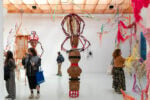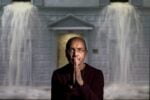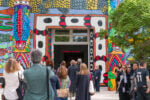Vassily Kandinsky – La collezione del Centre Pompidou
.jpg)
La mostra è una grande retrospettiva monografica che presenta oltre 80 opere fondamentali dell’arte di Kandinsky in ordine cronologico.
Comunicato stampa
La mostra, che si apre a Palazzo Reale il 17 dicembre, racconta il viaggio artistico e spirituale di uno dei pionieri dell’arte astratta: Vassily Kandinsky.
Promossa e prodotta dall’Assessorato alla Cultura del Comune di Milano, Palazzo Reale, il Centre Pompidou di Parigi, 24 ORE Cultura – Gruppo 24 ORE e Arthemisia Group, l’esposizione, a cura di Angela Lampe – storica dell’arte nonché curatrice e conservatrice del Centre Pompidou di Parigi – e in collaborazione per l’Italia con Ada Masoero, è una grande retrospettiva monografica che presenta oltre 80 opere fondamentali dell’arte di Kandinsky in ordine cronologico.
Folgorato dalla visione di “I covoni” di Claude Monet nella mostra degli Impressionisti a Mosca nel 1896, Kandinsky lascia la carriera universitaria per diventare pittore. Segue il classico cursus degli studi sotto la guida di grandi maestri come Anton Azbé e Franz von Stuck a Monaco e soggiorna dal 1906 al 1907 a Sèvre, vicino a Parigi (Il parco di Saint-Cloud, viale ombreggiato, Le Parc de Saint‐Cloud, allée ombragée, 1906).
Sviluppa così il suo pensiero artistico, che abbraccia numerosi campi, la pittura, la musica, il teatro nei quali cerca e difende lo spirituale nell’arte, titolo di un suo saggio fondamentale.
Il visitatore percorrerà le sezioni della mostra organizzata secondo i periodi principali della vita di Kandinsky, dagli esordi in Germania agli anni in Russia e in Francia poi. Scoprirà numerose e fondamentali opere da Città vecchia II (Alte Stadt II, 1902) a Azzurro cielo (Bleu de ciel, 1940) passando attraverso Mulino, Olanda (Mühle, Holland 1904), Nel grigio (Im Grau, 1919), Giallo-Rosso-Blu (Gelb‐Rot‐Blau, 1925) e Ammasso regolato (Entassement réglé, 1938).
Il percorso espositivo comincia in modo sorprendente, “immergendo” il visitatore in un ambiente che avrà “il potere di trasportarlo fuori dallo spazio e dal tempo”: una sala con pitture parietali. Ricreata nel 1977 dal pittore restauratore Jean Vidal queste pitture sono state concepite rispettando fedelmente i cinque guazzi originali, eseguiti da Kandinsky per decorare un salone ottagonale della Juryfreie Kunstausstellung, una mostra senza giuria che si svolse annualmente a Berlino tra il 1911 e il 1930. Questi cinque guazzi sono entrati nella collezione del museo, in seguito alla donazione della vedova Nina nel 1976 al Pompidou.
Organizzata secondo un criterio cronologico, la mostra presenta quattro sezioni che si sviluppano lungo otto sale.
A Monaco: 1896 – 1914
Nel 1896 Kandinsky si trasferisce dalla Russia a Monaco per studiare pittura. La città tedesca in quel momento sta abbandonando la moda simbolista per diventare la capitale europea del Jugendstil (Art Nouveau), una corrente artistica che cerca la via dell’arte attraverso i progetti decorativi. Kandinsky esordisce con piccoli paesaggi ancora tardo-impressionisti come in Schwabing, sole invernale (Schwabing, Wintersonne, 1901) e con tempere simboliste dai colori lucenti, ispirate alle antiche leggende germaniche e alla vita della vecchia Russia come in Scena russa, domenica (Vecchia Russia), 1903-04. È però dal 1908, nei soggiorni estivi a Murnau, dove la sua compagna comprò una casa, che crea i primi dipinti in cui, servendosi di colori accesi e antinaturalistici, traduce la realtà in immagini piatte, prive di volume, ispirate alla pittura fauve. Il paesaggio diventa così pretesto per esercizi sulla forma e per indagini sulla forza del colore, con cui avvia il primo processo di astrazione dal reale (Improvvisazione III, Improvisation III, 1909).
E’ a Monaco che Kandinsky scrive “Dello spirituale nell’arte” (Über das Geistige in der Kunst), in cui affronta lucidamente sul piano teorico ciò che andava sperimentando nella sua pittura, dal rapporto tra forma e colore a quello per lui fondamentale tra colore e suono, alla base dell’astrazione. Con l’amico Franz Marc, sviluppò il progetto del Cavaliere Azzurro che produrrà due mostre tra il 1911 e il 1912 e, nel maggio 1912, il celebre Almanacco del Cavaliere azzurro, dove musica e arti visive si intrecciano strettamente e si valorizza il ruolo delle arti popolari e “primitive” in funzione di un rinnovamento radicale della pittura. In questi anni Kandinsky crea le sue prime opere totalmente svincolate dal reale (Quadro con macchia rossa, Bild mit rotem Fleck, 25 febbraio 1914), che traducono in immagini astratte il suo mondo interiore.
Di nuovo in Russia: 1914-1921
Scoppiata la Prima guerra mondiale, Kandinsky è costretto a rientrare a Mosca, lasciando alla compagna tedesca Gabriele Münter quasi tutte le opere monacensi. Nel 1915 non dipinge ma lavora solo su carta (Senza titolo, 1915) e solo nel 1916 si dedica nuovamente alla pittura. Dopo un breve ritorno alla figurazione successivo al matrimonio con la giovanissima Nina Andreevskaja, con lo scoppio della Rivoluzione d’Ottobre Kandinsky viene coinvolto dai rivoluzionari nelle nuove istituzioni culturali, dove fino al 1920 occupa ruoli di prestigio. Assorbito dagli incarichi istituzionali dipinge poco, ribadendo ora la sua scelta definitiva per l’astrazione (vedi l’opera fondamentale Nel grigio, Im Grau, 1919), ma l’avanguardia costruttivista più giovane e radicale lo osteggia per il suo espressionismo spirituale, e nel 1921 decide di tornare in Germania.
Gli anni del Bauhaus: 1921-1933
Celebre per i suoi scritti, Kandinsky viene invitato da Walter Gropius a insegnare al Bauhaus, prestigiosa scuola di architettura e arte dove dal 1922 è docente di Decorazione murale e già nel 1922 concepisce e realizza con i suoi studenti la grandiosa decorazione per l’atrio della Juryfreie di Berlino. Dello stesso anno è anche la cartella grafica Piccoli Mondi (Kleine Welten), sintesi della sue opere espressioniste prima della guerra e del suo nuovo stile più geometrico del periodo russo e del nuovo sviluppo del Bauhaus (vedi Griglia nera, Schwarzer Raster, 1922). Questi anni al Bauhaus sono caratterizzati dall’amicizia con il vecchio amico Paul Klee e dalla pubblicazione dell’altro suo principale saggio “Punto e linea sul piano” (Punkt un Linie zu Fläche, 1926). I titoli stessi delle sue opere mettono in evidenza il rapporto tra i colori e le forme geometriche, (Arancione, Schwarzer Raster 1923; Su bianco II, Auf Weiss II 1923; Giallo-Rosso-Blu, Gelb‐Rot‐Blau 1925); nel 1930 si affacciano le prime forme organiche. La chiusura del Bauhaus, imposta dai nazisti nel 1933, lo costringe a emigrare di nuovo, questa volta verso Parigi.
Parigi: 1933-1944
La Parigi in cui Kandinsky arriva nel 1933 è sì la capitale del mercato dell’arte, ma è anche una città devota ai suoi soli artisti (Picasso e i Surrealisti soprattutto), poco interessata all’astrazione pura di un artista russo di nazionalità tedesca. I Kandinsky si stabiliscono a Neuilly-sur-Seine, in un edificio affacciato sulla Senna e sul Bois-de-Boulogne: quella luce chiara e tersa seduce l'artista che schiarisce la tavolozza. Intanto nei suoi dipinti e nei lavori su carta, anche per l’influsso degli amici surrealisti Jean Arp e Joan Miró, si moltiplicano le forme biomorfe: amebe, creature degli abissi, embrioni, insetti (vedi Ammasso regolato, Entassement réglé, 1938; Azzurro cielo, Bleu de ciel, 1940; Una festa privata, Une Fête intime, 1942). Un microcosmo in cui Kandinsky si immerge, anche per fuggire l’angoscia della guerra. Muore il 13 dicembre 1944, senza vedere la fine del conflitto.
The show opening at Palazzo Reale on 17 December recounts the artistic and spiritual journey of Vassily Kandinsky, one of the pioneers of abstract art.
Promoted and produced by the Milan department of culture, Palazzo Reale, the Centre Pompidou, 24 ORE Cultura - Gruppo 24 ORE and Arthemisia Group, this major exhibition presenting over 80 key works by Kandinsky in chronological order is curated by art historian Angela Lampe of the Centre Pompidou and, for Italy, by Ada Masoero.
Deeply impressed by Monet’s Haystacks series at the Impressionist exhibition of 1896 in Moscow, Kandinsky abandoned a university career to become a painter. In addition to undertaking the classic course of studies under the guidance of masters such as Anton Azbé and Franz von Stuck in Munich, he stayed at Sèvres near Paris from 1906 to 1907 (Park of Saint-Cloud, 1906). He thus developed and artistic vision encompassing numerous fields, from painting to music and theatre, in which he sought and defended what he defined in his well-known text as “the spiritual in art”.
The show is organized in sections corresponding to the major periods in Kandinsky’s life, from the early years in Germany to those in Russia and then France, providing an opportunity to discover a host of crucial works such as Old Town (1902), Windmill in Holland (1904), In Grey (1919), Yellow-Red-Blue (1925), Colourful Ensemble (1938) and Sky Blue (1940).
The exhibition opens with a surprise, plunging visitors into an environment endowed with “the power to transport them outside space and time”. The wall paintings of this initial room, recreated in 1977 by the painter restorer Jean Vidal, faithfully reflect the five original gouaches that Kandinsky produced for an octagonal room at the Juryfreie Kunstausstellung, the “jury-less show” held annually in Berlin from 1911 to 1930. The gouaches were among the works donated to the Centre Pompidou by the artist’s widow Nina in 1976.
The exhibition develops in chronological order in four sections over eight rooms.
Munich, 1896–1914
Kandinsky moved from Russia to Munich to study painting in 1896, when the city was abandoning Symbolism to become a European capital of the Jugendstil or Art Nouveau, a movement pursuing the path of art through decorative projects. Kandinsky began with small, late-Impressionist landscapes like Schwabing (1901) and works of glowing colour in tempera inspired by ancient Germanic legends and the life of old Russia (Old Russia, 1903–04). It was, however, as from 1908, during summer stays at Murnau, where his mistress Gabriele Münter bought a house, that he created the first works using bright colours to translate reality into flat, two-dimensional images inspired by Fauvism. Landscape thus became a pretext for exercises on form and investigations into the power of colour leading to the initial process of abstraction (Improvisation III, 1909).
Kandinsky wrote Concerning the Spiritual in Art in Munich, a lucid theoretical analysis of his pictorial experimentation, from the relationship between form and colour to that between colour and sound. He led the Blaue Reiter project with his friend Franz Marc, which was to hold two shows in the period 1911–12 and produce in May 1912 the celebrated Blaue Reiter Almanach, where music and visual arts were closely entwined and popular and where “primitive” arts were assigned a primary role in a radical renewal of painting. Kandinsky created his first works totally detached from reality during this period (Painting with Red Spot, 1914), translations of his inner world into abstract images.
Back in Russia,1914–21
When World War I broke out, Kandinsky was forced to return to Moscow and left nearly all the works produced in Munich with Gabriel Münter. He worked exclusively on paper in 1915 (Untitled, 1915) and only resumed painting in 1916. After marrying the much younger Nina Andreyevskaya and returning briefly to figuration, he was caught up in the aftermath of the October Revolution and occupied key roles in the new cultural institutions until 1920. While he painted little due to his official commitments, he now espoused abstract art definitively (as in the crucial work In Grey, 1919). Having come under attack from the younger and more radical constructivist avant-garde for his spiritual expressionism, he thus decided to return to Germany in 1921.
The Bauhaus years, 1921–33
Kandinsky, who gained recognition for his written work, was invited by Walter Gropius to teach at the prestigious school of architecture and art known as the Bauhaus. He took charge of the wall paintings course in 1922 and produced the huge decorations for the atrium of the Berlin Juryfreie Kunstausstellung with his students in the same year. 1922 also saw the Small Worlds portfolio of prints, a synthesis of his pre-war Expressionist works, the new and more geometric style of the Russian period and the new developments of the Bauhaus (Black Grid, 1922). The years at the Bauhaus saw close friendship with Paul Klee and the publication of Kandinsky’s other major theoretical work Point and Line to Plane (1926). The titles of his paintings – Orange (1923), On White II (1923), Yellow-Red-Blue (1925) – highlight the relationship between colours and geometric shapes. The first organic forms made their appearance in 1930. The closure of the Bauhaus in 1933 under pressure from the Nazi regime forced him to move again, this time to Paris.
Paris, 1933–44
Kandinsky arrived in Paris in 1933. While indisputably the capital of the art market, the city was also devoted to its own artists (Picasso and the Surrealists above all) and had little interest in the pure abstraction of a Russian artist with German citizenship. Kandinsky moved into a house at Neuilly-sur-Seine looking onto the river and the Bois-de-Boulogne. Enchanted by the limpid, crystalline light, he lightened his palette. At the same time, not least through the influence of his Surrealist friends Jean Arp and Joan Miró, his paintings and works on paper saw a proliferation of biomorphic forms, amoebae, creatures of the depths, embryos and insects (Colourful Ensemble, 1938; Sky Blue, 1940; An Intimate Celebration, 1942). Kandinsky plunged into this microcosm, also in order to escape from the anguish of war. He died on 13 December 1944 without seeing the end of the fighting.



